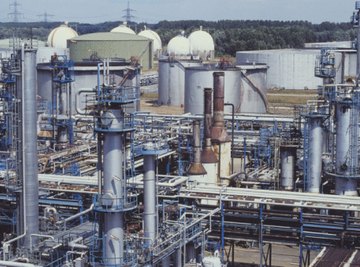
Hydrocarbons are molecules of carbon hydrogen and oxygen that have different chemical and physical properties depending on the structure of their bonding. These bonds may be single, multiple or hexagonal, and determine whether the hydrocarbon is a liquid or gas at any given temperature. Hydrocarbon gas is also known as natural gas and forms in the Earth’s crust from decomposing organic matter. It is a mixture of different hydrocarbons that condense into liquids at different temperatures.
Methane
Methane is the lightest and most common hydrocarbon gas, consisting of one carbon molecule. It is used in domestic and commercial heating and as a cooking fuel worldwide. Its main industrial applications are in electric power generation, and for the production of methanol. Methane is transported by pipeline in gaseous form or by tanker in a compressed liquefied form known as liquefied natural gas (LNG).
Ethane
A two-carbon molecule, ethane is the second-largest component of hydrocarbon gas after methane. After separation from methane in a refrigeration process, ethane becomes the principal feedstock in the manufacture of commodity petrochemicals. A process of steam cracking converts ethane into ethylene.
Propane
A byproduct of hydrocarbon gas processing, propane consists of a three-carbon molecule. Propane liquefies at moderate pressures compared to methane and ethane. Stored in canisters, it is easily transported and used as a domestic cooking fuel in areas where a natural gas pipeline infrastructure does not exist. Its other main use is as a transportation fuel commonly known as liquefied petroleum gas or LPG.
Butane
Butane consists of a four-carbon molecule. Mixed with propane in canisters, its main use is as a cooking gas on campsites. Butane is the fuel in cigarette lighters and a propellant in aerosols and deodorants.
Pentane
This five-carbon molecule gas is volatile at room temperature. Its main industrial use is as an organic solvent in chemical laboratories and as a foaming agent in the production of polystyrene.
Hexane
The main applications for hexane, a six-carbon molecule, is in the production of gasoline, glue and as an agent in food processing. Hexane has a mild anesthetic effect but damages the human nervous system.
References
Resources
About the Author
Based in London, Maria Kielmas worked in earthquake engineering and international petroleum exploration before entering journalism in 1986. She has written for the "Financial Times," "Barron's," "Christian Science Monitor," and "Rheinischer Merkur" as well as specialist publications on the energy and financial industries and the European, Middle Eastern, African, Asian and Latin American regions. She has a Bachelor of Science in physics and geology from Manchester University and a Master of Science in marine geotechnics from the University of Wales School of Ocean Sciences.
Photo Credits
NA/AbleStock.com/Getty Images
